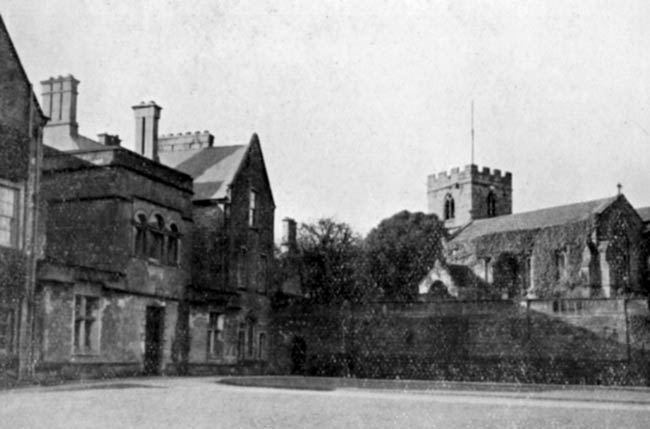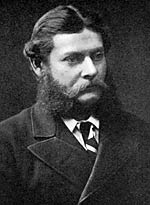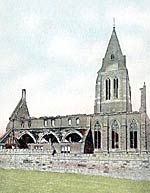< Previous | Contents | Next >
Byron's First Love
ANNESLEY. There is old and new Annesley, but it is the old that has come into story, for here with the ruined church is Annesley Hall, home of Mary Chaworth. It stands in a park with a lake, and has been the home of the Chaworth-Musters family since Byron's first love brought together the two families by her marriage. The Chaworths have lived in Notts since the Conquest, their chief homes being at Wiverton and Annesley.

Annesley Hall and church in the 1930s.
The beautiful Mary was the last of her house, and the romance of Byron's boyhood love for the "bright morning star of Annesley" must always cling to this place. In the park is Diadem Hill, 578 feet above the sea and seen for miles round. It was here that Byron and Mary often met, and here they parted, after which Annesley lost its enchantment for the poet:
Hills of Annesley, bleak and barren,
Where my thoughtless childhood strayed,
How the northern tempests, warring,
Howl above thy tufted shade.
Now no more, the hours beguiling,
Former favourite haunts I see,
Now no more my Mary smiling
Makes ye seem a heaven to me.
He was genuinely in love with her, but she did not return his love, and before he went to Cambridge she had married John Musters, the sporting squire of Colwick Hall. She died in 1832 as a result of exposure during an attack on the hall by Reform Bill rioters.
Mary was the heiress of William Chaworth who was killed in a duel with his cousin, the 5th Lord Byron, great-uncle of the poet. The duel arose from an after-dinner quarrel at an inn in Pall Mall, Chaworth and Byron settling the dispute by fighting in a room lit only by a candle and a dying fire. Lord Byron was tried by the peers and found guilty of manslaughter, but the verdict brought only nominal punishment. Chaworth lies in the ruined old church.

George Chaworth-Musters (1841-1879).
In the old churchyard, under a monument showing an anchor on a piled heap of stones, sleeps that George Chaworth-Musters who was traveller and explorer and almost a king. Born at Naples while his parents were travelling, he became himself a great traveller, and while he was only 21, being then in the navy, he and a midshipman climbed the famous Sugar Loaf Mountain and planted the British ensign on the top, where it remained for years before anyone climbed up to bring it down. Out in South America he settled down sheep farming, and later began exploring. He lived on terms of great friendliness with the natives of Patagonia, who treated him as a king. He travelled 1400 miles on a journey which added much to our knowledge of South America and its people, and was given the gold medal of the Royal Geographical Society. Oh returning to England after his sojourn in Patagonia he found it hard to fall into civilised ways and used to sleep in the garden wrapped in a blanket.
Though the old church is unsafe now even for visiting, there is enough of it left to tell of its beauty. The 14th century tower still has its belfry windows, and the south aisle has a lovely east window and fine sedilia. This aisle was added in the 14th century as a chantry, and was known as Felley Chapel after a small priory founded two miles away in the 12th century. Only a few fragments of the priory are left, and on its site is a charming brick house with many gables, in lovely gardens and in a delightful situation. James the First gave Felley to Anthony Millington in 1603, and Anthony's son Gilbert signed the death-warrant of Charles Stuart.

Annesley new church after the fire of 1907.
Two treasures from the old church are in the new one high on the hilltop, its tower and spire a landmark. Built in 1874, and made new this century after a fire, it is spacious and full of light, with nave arches on clustered pillars and four canopied angels marking the entrance to the chancel. The glass of the great east window, which pleases both by its colour and its delicate treatment, is in memory of a vicar whose portrait is in it; ten Bible scenes and a Crucifixion glow in red, blue, green, and gold, and there are small medallion heads of disciples. Three charming windows at the west end show Our Lord with a child on His knee, an angel holding lilies and a crown, and a winged knight with scales and a sword.
One of the old treasures is a splendid Norman font like a tub, carved with lattice pattern and a band of stars. Another is the alabaster figure of a man wearing a round embroidered cap with scalloped edge, a sheet draped over him. A striking and unusual 20th century font of white marble has an oblong bowl carved all over with birds and animals in foliage. Among a number of brass inscriptions to the Chaworth-Musters family is one with little colour engravings of the regimental badges of four who gave their lives in the war. Three were brothers who lived at Annesley Hall, and one a cousin, all very young, and at the foot of the brass are the words, "In the morning of their lives."
